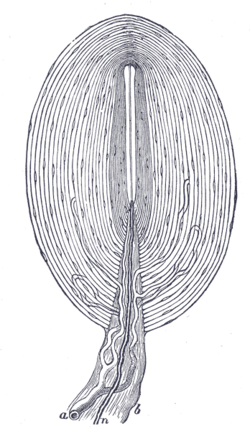| Pacinian corpuscle | |
|---|---|
 Pacinian corpuscle, with its system of capsules and central cavity. a. Arterial twig, ending in capillaries, which form loops in some of the intercapsular spaces, and one penetrates to the central capsule. b. The fibrous tissue of the stalk. n. Nerve tube advancing to the central capsule, there losing its white matter and stretching along the axis to the opposite end, where it ends by a tuberculated enlargement. | |
 Pacinian corpuscle labeled at bottom | |
| Details | |
| Location | Skin |
| Identifiers | |
| Latin | corpusculum Pacinian |
| MeSH | D010141 |
| TH | H3.11.06.0.00009 |
| FMA | 83604 |
| Anatomical terms of microanatomy | |
The Pacinian corpuscle (also lamellar corpuscle, or Vater-Pacini corpuscle)[1] is a low-threshold mechanoreceptor responsive to vibration or pressure, found in the skin and other internal organs.[2] In the skin it is one of the four main types of cutaneous receptors.
The corpuscles are present in skin notably on both surfaces of the hands and feet, arms, and neck.[3] Pacinian corpuscles are also found on bone periosteum, joint capsules, the pancreas and other internal organs, the breast, genitals,[4] and lymph nodes.[5]
Pacinian corpuscles are rapidly adapting mechanoreceptors. As phasic receptors they respond quickly but briefly to a stimulus with the response diminishing even when the stimulus is maintained.[6] They primarily respond to vibration, and deep pressure. They are especially sensitive to high-frequency vibrations. Groups of corpuscles sense pressure changes (such as on grasping or releasing an object). They are additionally crucially involved in proprioception.[1] The vibrational role may be used for detecting surface texture, such as rough and smooth.[citation needed]
- ^ a b Germann, C.; Sutter, R.; Nanz, D. (June 2021). "Novel observations of Pacinian corpuscle distribution in the hands and feet based on high-resolution 7-T MRI in healthy volunteers". Skeletal Radiology. 50 (6): 1249–1255. doi:10.1007/s00256-020-03667-7. PMC 8035111. PMID 33156397.
- ^ Cobo, R; García-Piqueras, J; Cobo, J; Vega, JA (10 January 2021). "The Human Cutaneous Sensory Corpuscles: An Update". Journal of Clinical Medicine. 10 (2): 227. doi:10.3390/jcm10020227. PMC 7827880. PMID 33435193.
- ^ Standring, Susan (2020). Gray's Anatomy: The Anatomical Basis of Clinical Practice (42th ed.). New York: Elsevier. pp. 63–64. ISBN 978-0-7020-7707-4. OCLC 1201341621.
- ^ Clark, Mary Ann; Douglas, Matthew; Choi, Jung (28 March 2018). "36.2 Somatosensation - Biology 2e | OpenStax". openstax.org. Retrieved 2 October 2024.
- ^ Feito, J.; Cobo, J.L.; Santos‐Briz, A.; Vega, J.A. (2017). "Pacinian Corpuscles in Human Lymph Nodes". The Anatomical Record. 300 (12). Wiley: 2233–2238. doi:10.1002/ar.23679. ISSN 1932-8486.
- ^ Cite error: The named reference
Purveswas invoked but never defined (see the help page).